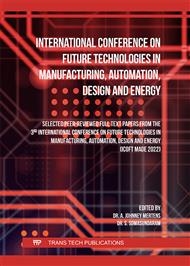[1]
J. Zhang, L. Zhang, F. Sun and Z. Wang, "An Overview on Thermal Safety Issues of Lithium-ion Batteries for Electric Vehicle Application," in IEEE Access, vol. 6, pp.23848-23863, 2018
DOI: 10.1109/ACCESS.2018.2824838
Google Scholar
[2]
Rao, Z. H., and Wang, S. F., 2011, "A Review of Power Battery Thermal Energy Management," Renewable Sustainable Energy Rev., 15(9), p.4554–4571
DOI: 10.1016/j.rser.2011.07.096
Google Scholar
[3]
Aldosry, A.M.; Zulkifli, R.; Wan Ghopa, W.A. Heat Transfer Enhancement of Liquid Cooled Copper Plate with Oblique Fins for Electric Vehicles Battery Thermal Management. World Electr. Veh. J. 2021, 12, 55
DOI: 10.3390/wevj12020055
Google Scholar
[4]
Dafen Chen, Jiuchun Jiang, Gi-Heon Kim, Chuanbo Yang, Ahmad Pesaran,Comparison of different cooling methods for lithium-ion battery cells,Applied Thermal Engineering,Volume 94,2016.
DOI: 10.1016/j.applthermaleng.2015.10.015
Google Scholar
[5]
Pesaran, Ahmad, S. Santhanagopalan, and G. H. Kim. Addressing the impact of temperature extremes on large format li-ion batteries for vehicle applications (presentation). No. NREL/PR-5400-58145. National Renewable Energy Lab.(NREL), Golden, CO (United States), 2013.
DOI: 10.2172/416098
Google Scholar
[6]
JTAC, EVAC with BCS Layout
Google Scholar
[7]
CP Arora, Refrigeration and Air Conditioning
Google Scholar
[8]
K. Karthikeyan | C. Saravanan | Dr. T. Senthil Kumar "Enhancement of Heat Transfer Analysis and Optimization of Engine Fins of Varying Geometry" Published in International Journal of Trend in Scientific Research and Development (ijtsrd), ISSN: 2456-6470, Volume-2
DOI: 10.31142/ijtsrd14327
Google Scholar
[9]
Kumar, Rajat and Singh, Devendra and Sharma, Ajay Kumar, Static Thermal Analysis of Fins Models Using ANSYS (February 18, 2020). International Journal of Mechanical Engineering and Technology 11(2), 2020, pp.10-21
DOI: 10.34218/ijmet.11.2.2020.002
Google Scholar
[10]
Prabhu, L., et al. "Design and analysis of different types of fin configurations using ANSYS." International Journal of Pure and Applied Mathematics 118.5 (2018): 1011-1017.
Google Scholar
[11]
S.S. Joshi, A.B. Ganorkar. Use of Fins and Inserts as Passive Heat Transfer Augmentation Techniques.Research J. Engineering and Tech. 2(3): July-Sept. 2011 page 133-141
Google Scholar
[12]
Xujian Cui, Siqi Chen, Mi Xiao and Wei Li. 2021. A Computational Fluid Dynamics Coupled Multi-Objective Optimization Framework for Thermal System Design for Li-Ion Batteries with Metal Separators. Journal of Electrochemical Energy Conversion and Storage.
DOI: 10.1115/1.4050509
Google Scholar
[13]
T U H S G Manik, G Sudrajat1 and T B Sitorus. 2019. The experimental study of the coolant flow rate of an ethylene glycol-mixed water to the heat transfer rate on the radiator. OP Conference Series: Materials Science and Engineering.
DOI: 10.1088/1757-899x/505/1/012063
Google Scholar


